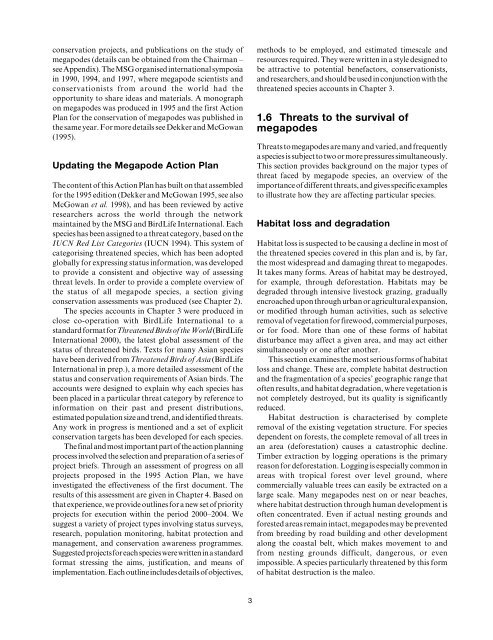Megapodes: Status Survey and Conservation Action Plan ... - IUCN
Megapodes: Status Survey and Conservation Action Plan ... - IUCN
Megapodes: Status Survey and Conservation Action Plan ... - IUCN
Create successful ePaper yourself
Turn your PDF publications into a flip-book with our unique Google optimized e-Paper software.
conservation projects, <strong>and</strong> publications on the study of<br />
megapodes (details can be obtained from the Chairman –<br />
see Appendix). The MSG organised international symposia<br />
in 1990, 1994, <strong>and</strong> 1997, where megapode scientists <strong>and</strong><br />
conservationists from around the world had the<br />
opportunity to share ideas <strong>and</strong> materials. A monograph<br />
on megapodes was produced in 1995 <strong>and</strong> the first <strong>Action</strong><br />
<strong>Plan</strong> for the conservation of megapodes was published in<br />
the same year. For more details see Dekker <strong>and</strong> McGowan<br />
(1995).<br />
Updating the Megapode <strong>Action</strong> <strong>Plan</strong><br />
The content of this <strong>Action</strong> <strong>Plan</strong> has built on that assembled<br />
for the 1995 edition (Dekker <strong>and</strong> McGowan 1995, see also<br />
McGowan et al. 1998), <strong>and</strong> has been reviewed by active<br />
researchers across the world through the network<br />
maintained by the MSG <strong>and</strong> BirdLife International. Each<br />
species has been assigned to a threat category, based on the<br />
<strong>IUCN</strong> Red List Categories (<strong>IUCN</strong> 1994). This system of<br />
categorising threatened species, which has been adopted<br />
globally for expressing status information, was developed<br />
to provide a consistent <strong>and</strong> objective way of assessing<br />
threat levels. In order to provide a complete overview of<br />
the status of all megapode species, a section giving<br />
conservation assessments was produced (see Chapter 2).<br />
The species accounts in Chapter 3 were produced in<br />
close co-operation with BirdLife International to a<br />
st<strong>and</strong>ard format for Threatened Birds of the World (BirdLife<br />
International 2000), the latest global assessment of the<br />
status of threatened birds. Texts for many Asian species<br />
have been derived from Threatened Birds of Asia (BirdLife<br />
International in prep.), a more detailed assessment of the<br />
status <strong>and</strong> conservation requirements of Asian birds. The<br />
accounts were designed to explain why each species has<br />
been placed in a particular threat category by reference to<br />
information on their past <strong>and</strong> present distributions,<br />
estimated population size <strong>and</strong> trend, <strong>and</strong> identified threats.<br />
Any work in progress is mentioned <strong>and</strong> a set of explicit<br />
conservation targets has been developed for each species.<br />
The final <strong>and</strong> most important part of the action planning<br />
process involved the selection <strong>and</strong> preparation of a series of<br />
project briefs. Through an assessment of progress on all<br />
projects proposed in the 1995 <strong>Action</strong> <strong>Plan</strong>, we have<br />
investigated the effectiveness of the first document. The<br />
results of this assessment are given in Chapter 4. Based on<br />
that experience, we provide outlines for a new set of priority<br />
projects for execution within the period 2000–2004. We<br />
suggest a variety of project types involving status surveys,<br />
research, population monitoring, habitat protection <strong>and</strong><br />
management, <strong>and</strong> conservation awareness programmes.<br />
Suggested projects for each species were written in a st<strong>and</strong>ard<br />
format stressing the aims, justification, <strong>and</strong> means of<br />
implementation. Each outline includes details of objectives,<br />
methods to be employed, <strong>and</strong> estimated timescale <strong>and</strong><br />
resources required. They were written in a style designed to<br />
be attractive to potential benefactors, conservationists,<br />
<strong>and</strong> researchers, <strong>and</strong> should be used in conjunction with the<br />
threatened species accounts in Chapter 3.<br />
1.6 Threats to the survival of<br />
megapodes<br />
Threats to megapodes are many <strong>and</strong> varied, <strong>and</strong> frequently<br />
a species is subject to two or more pressures simultaneously.<br />
This section provides background on the major types of<br />
threat faced by megapode species, an overview of the<br />
importance of different threats, <strong>and</strong> gives specific examples<br />
to illustrate how they are affecting particular species.<br />
Habitat loss <strong>and</strong> degradation<br />
Habitat loss is suspected to be causing a decline in most of<br />
the threatened species covered in this plan <strong>and</strong> is, by far,<br />
the most widespread <strong>and</strong> damaging threat to megapodes.<br />
It takes many forms. Areas of habitat may be destroyed,<br />
for example, through deforestation. Habitats may be<br />
degraded through intensive livestock grazing, gradually<br />
encroached upon through urban or agricultural expansion,<br />
or modified through human activities, such as selective<br />
removal of vegetation for firewood, commercial purposes,<br />
or for food. More than one of these forms of habitat<br />
disturbance may affect a given area, <strong>and</strong> may act either<br />
simultaneously or one after another.<br />
This section examines the most serious forms of habitat<br />
loss <strong>and</strong> change. These are, complete habitat destruction<br />
<strong>and</strong> the fragmentation of a species’ geographic range that<br />
often results, <strong>and</strong> habitat degradation, where vegetation is<br />
not completely destroyed, but its quality is significantly<br />
reduced.<br />
Habitat destruction is characterised by complete<br />
removal of the existing vegetation structure. For species<br />
dependent on forests, the complete removal of all trees in<br />
an area (deforestation) causes a catastrophic decline.<br />
Timber extraction by logging operations is the primary<br />
reason for deforestation. Logging is especially common in<br />
areas with tropical forest over level ground, where<br />
commercially valuable trees can easily be extracted on a<br />
large scale. Many megapodes nest on or near beaches,<br />
where habitat destruction through human development is<br />
often concentrated. Even if actual nesting grounds <strong>and</strong><br />
forested areas remain intact, megapodes may be prevented<br />
from breeding by road building <strong>and</strong> other development<br />
along the coastal belt, which makes movement to <strong>and</strong><br />
from nesting grounds difficult, dangerous, or even<br />
impossible. A species particularly threatened by this form<br />
of habitat destruction is the maleo.<br />
3
















